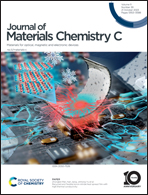From aggregation-caused quenching to aggregation-induced delayed fluorescence: the impact of the effect of substituents†
Abstract
The developments of aggregation-induced delayed fluorescence (AIDF) emitters are vital for enhancing the efficiency of non-doped organic light-emitting diodes (OLEDs). However, severe exciton quenching is still a key problem to be solved. Here, the electroluminescent mechanism of four imidazole-based luminogens, namely DMAC-CNIH, DMAC-CNIB, DMAC-CNIM and DMAC-CNBIM, are explored based on density functional theory (DFT) and time-dependent density functional theory (TD-DFT) methods. The polarizable continuum model and quantum mechanics and molecular mechanics (QM/MM) methods are used to investigate the excited state dynamics in toluene and crystal states, respectively. The results show that DMAC-CNIH exhibits an aggregation-caused quenching (ACQ) characteristic, whereas introducing different substituents to the imidazole group cause DMAC-CNIB, DMAC-CNIM and DMAC-CNBIM to show an AIDF property. The first singlet–triplet energy gap (ΔEST) of DMAC-CNIH is larger in the solid state than that in toluene. Conversely, the ΔEST of DMAC-CNIB and DMAC-CNBIM are all decreased significantly in the solid state when compared with those in toluene. Although the ΔEST of DMAC-CNIM is larger in the solid state than that in toluene, the energy gap between the S1 and T2 states is as small as 0.01 eV, which facilitates the occurrence of the intersystem crossing (ISC) process. The KISC and KRISC for the molecules investigated were all as small as about 103 s−1 in toluene. For DMAC-CNIH, the KISC in the solid state is increased to 7.96 × 107 s−1, whereas the KRISC is only 1.68 × 103 s−1, indicating that the reverse intersystem crossing (RISC) process is difficult to achieve in the solid state. However, the KISC and KRISC for DMAC-CNIB and DMAC-CNBIM in the solid state are significantly increased to about 106 and 107 s−1, respectively. In particular, the KISC and KRISC for the DMAC-CNIM are as high as 8.68 × 108 and 6.09 × 108 s−1, respectively. The stronger intermolecular interactions of DMAC-CNIB, DMAC-CNIM and DMAC-CNBIM also enhance the RISC processes and the efficient thermally activated delayed fluorescent (TADF) properties can be expected in the solid state. The analysis of reorganization energies in both toluene and solid states explains the aggregation-induced emission (AIE) characteristics of DMAC-CNIB, DMAC-CNIM and DMAC-CNBIM. In addition, the charge transport properties are evaluated based on Marcus theory. Results show that DMAC-CNIM possesses more balanced charge transport properties than the other molecules, which is beneficial for achieving a high fluorescent efficiency.

- This article is part of the themed collection: #MyFirstJMCC


 Please wait while we load your content...
Please wait while we load your content...